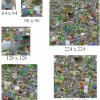Free Online Productivity Tools
i2Speak
i2Symbol
i2OCR
iTex2Img
iWeb2Print
iWeb2Shot
i2Type
iPdf2Split
iPdf2Merge
i2Bopomofo
i2Arabic
i2Style
i2Image
i2PDF
iLatex2Rtf
Sci2ools
CVPR
2007
IEEE
2007
IEEE
Hybrid learning of large jigsaws
A jigsaw is a recently proposed generative model that describes an image as a composition of non-overlapping patches of varying shape, extracted from a latent image. By learning the latent jigsaw image which best explains a set of images, it is possible to discover the shape, size and appearance of repeated structures in the images. A challenge when learning this model is the very large space of possible jigsaw pixels which can potentially be used to explain each image pixel. The previous method of inference for this model scales linearly with the number of jigsaw pixels, making it unusable for learning the large jigsaws needed for many practical applications. In this paper, we make three contributions that enable the learning of large jigsaws - a novel sparse belief propagation algorithm, a hybrid method which significantly improves the sparseness of this algorithm, and a method that uses these techniques to make learning of large jigsaws feasible. We provide detailed analysis of how...
Computer Vision | CVPR 2007 | Hybrid Inference Method | Hybrid Method | Large Jigsaws | Latent Jigsaw Image | Possible Jigsaw Pixels |
Related Content
| Added | 12 Oct 2009 |
| Updated | 28 Oct 2009 |
| Type | Conference |
| Year | 2007 |
| Where | CVPR |
| Authors | Julia A. Lasserre, Anitha Kannan, John M. Winn |
Comments (0)

